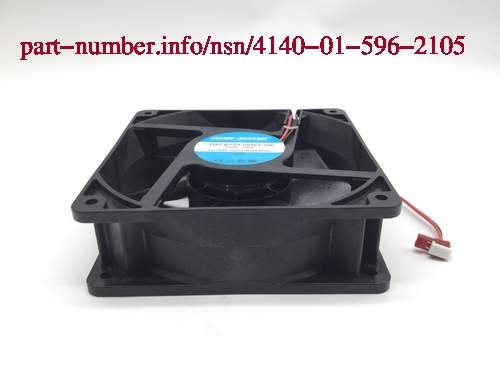4140015962105
4140-01-596-2105 Images
(for reference only)


Price Quote Get an up to date pricing and availability quote for this product. Order online or over the phone.
Quality Commitment
Serving our customers with quality and safety first.
- AS9120 Certified
- Audited supply chain
- ITAR Registered
- DDTC Registered
- HAZMAT Certified
- Customer service objectives
- Every product 100% inspected

4140-01-596-2105 Specification Set by the OEM (see RNCC code 3)
4.69in.
1.50in.
outward
direct
4 bolt
counterclockwise
97.0 cubic feet per minute
4.13in.
tubeaxial cooling fans model no. D47T15
frame: reinforced polybutylene plastic (UL94V-0 flame retardant) . impeller: reinformed polybutylene plastic (UL94V-s rating) . bearings: precision, LIFE-Lubricated ball bearings. insulation: class a integral ground system rated@ 248 degrees f (120 c) . weight: 9.2oz (260 grams) . operating temperature ra nge: 14 degress to 158 degrees f (-10 to 70 c) . insulation resistance: 10 megohms minumum @ 500 vdc. dielectric strength: 500 vac for 60 seconds. safety protection: electronic locked rotor protected; polarity protected. life expectancy: 75, 000 hours @ 77 degree f (25c) . terminals: 2 solder terminals: centers: .312in. thickness: .02in.. width: .120in.. length: .31inches. red lead is positive (+) , black lead is negative (-) , white leade is tachometer/snesor.
4.69in.
plastic
45 fixed
Cross Reference Parts Part numbers that meet the specification outlined on this page and set by the OEM
Identification Item Identification Guide (IIG) and Item Name Code (INC)
Definition Definition of approved item name (AIN): "FAN,TUBEAXIAL"
A nonpositive displacement mechanical device without guide vanes and having an axial fan impeller inclosed within a tubular housing. It is designed primarily for duct installation to move air or gas axially over a wide range of volumes at medium pressures.
4140-01-596-2105 Material Hazmat, Precious Metals, Criticality, Enviroment, and ESD
Indicates there is no data in the hmirs and the nsn is in a fsc not generally suspected of containing hazardous materials.
Item does not contain precious metal.
No known electrostatic discharge (esd) or electromagnetic interference (emi) sensitivity.
Represents items with no adp components
The item does not have a nuclear hardened feature or any other critical feature such as tolerance, fit restriction or application.
Identification Codes
HMIC: Hazardous Material Indicator Code. A one position code that identifies a hazardous item.
PMIC: Precious Metal Indicator Code. A one position code which identifies items that have precious metals as part of their content. precious metals are those metals generally considered to be uncommon, highly valuable, and relatively superior in certain properties such as resistance to corrosion and electrical conductivity.
ESD: Electrostatic Discharge. Indicates if an item is susceptible to electrostatic discharge or electromagnetic interference damage. electrostatic discharge damage occurs when an accumulation of static electricity generated by the relative motion or separation of materials is released to another item by direct contact. electromagnetic interference damage occurs when an item comes into proximity with an electrostatic or magnetic field.
ENAC: Enviromental Attribute Code. Identifies items with environmentally preferred characteristics.
CRITL: Criticality Indicator Code. Indicates an item is technically critical by tolerance, fit, application, nuclear hardness properties, or other characteristics.






